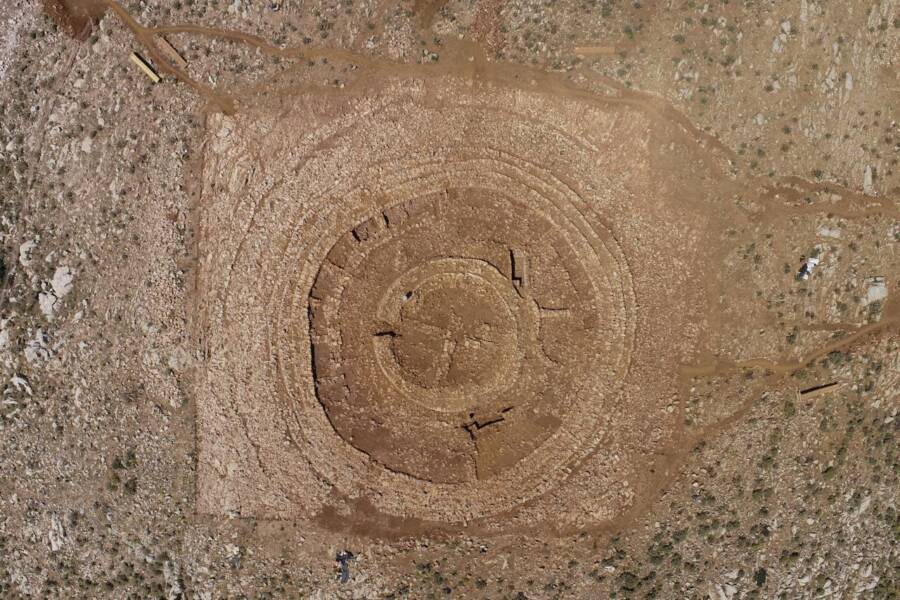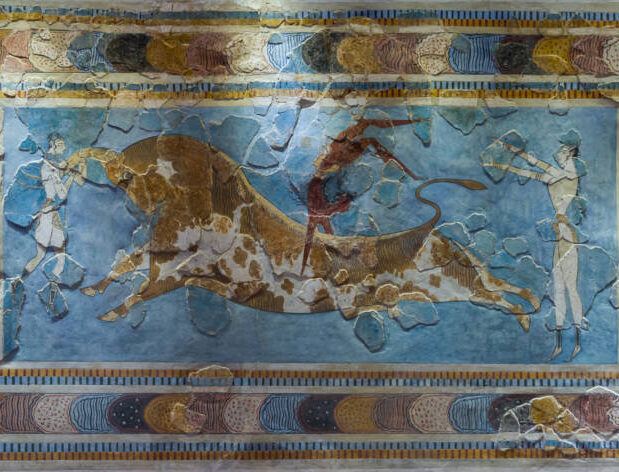The labyrinth was discovered at the highest point of Papoura Hill in Crete and was probably some kind of "community building."

Greek Ministry of CultureArchaeologists suspect that the structure was used between 2000 and 1700 B.C.E.
Greek mythology tells the story of the Minotaur, a fearsome creature imprisoned in a labyrinth in Crete. The story is presumed to be fictional — but archaeologists in Crete just discovered an ancient labyrinthine structure that they believe was used for rituals thousands of years ago.
The surprise discovery offers a peek into the Minoan civilization, which remains something of a mystery to researchers today.
A ‘Unique Find’: Discovering The Labyrinth
According to a press release from the Greek Ministry of Culture, the structure was first detected ahead of the construction of a radar system for a new airport. To the surprise of all involved, excavations on Papoura Hill — which has an elevation of approximately 1,600 feet — revealed the labyrinth.
The “monumental” structure consists of eight stone rings which are about five feet tall and surround a circular building with a diameter of about 50 feet, which is divided into four zones.

Greek Ministry of CultureThe labyrinth in Crete as seen from above.
“As the excavation progresses, an almost labyrinthine structure is revealed, as the spaces communicate with each other through narrow openings,” the press release notes. “Two possible main entrances to the central zones were revealed on the [southwest] and [northwest] sides.”
Archaeologists believe that the structure was used between 2000 and 1700 B.C.E., placing it well within the timeline of the Minoan civilization, which lasted from 3000 B.C.E. to roughly 1450 B.C.E. So, what exactly was this labyrinth structure used for — assuming it wasn’t to imprison the Minotaur?
Uncover The Latest History News On All That's Interesting
- Archaeologists Uncover 'Ghost Population' Of Previously-Unknown Human Ancestor
- Divers Find 27,000-Year-Old Fossils Of 13-Foot Sloth In Belizean Sinkhole
- 10-Year-Old Boy Discovers An 18th-Century Sword With A Metal Detector He Just Got For His Birthday
- Early Humans Used 2-Million-Year-Old Stone Balls To Get To Bone Marrow, New Study Finds
- This Ancient Human Brain Remained Almost Perfectly Intact For 2,600 Years — And Experts Might Finally Know Why
The Purpose Of The Labyrinth In Crete
As the press release notes, many questions still remain about the labyrinthine structure. For now, it’s not possible to determine its “original form” or “total height.” However, researchers do have some guesses about how Minoan people might have used the labyrinth thousands of years ago.
Other discoveries at the site, such as a large quantity of animal bones, suggest that the labyrinth was not inhabited as a “permanent residential” structure. Rather, it was probably used periodically for rituals that may have involved “the consumption of food, wine, and perhaps offerings.”

Greek Ministry of CultureLina Mendoni, the Greek Minister of Culture, examining the site with others.
But whatever it was used for, the layout of the labyrinth has struck researchers as rather unique.
“[T]he whole construction does not have an exact parallel with other buildings of the same period in Crete, although as a shape it is not unknown to us from architectural ensembles of the early Bronze Age in [the] Middle East,” the press release explains. It added: “Structural similarities, however, can also be found with the so-called vaulted tombs of the pre-palatial and palaeo-palatial period of southern Crete.”
As such, the labyrinth remains something of a mystery. However, it provides new clues about the mysterious Minoan people. Though archaeologists have documented plenty of their pottery, art, and jewelry, their main language has never been deciphered.

Jebulon/Wikimedia CommonsA bull fresco from the Minoan civilization, dating back to between 1600 and 1450 B.C.E.
In hopes of learning more, archaeologists next plan to continue their excavation of the labyrinth site. Regardless of what they find, it’s assured that the labyrinth will stand as a significant discovery.
“The completion of the excavation research is considered necessary, in order to clarify the character of the monument and its relationship with the residential and religious centers of the same period in the area of the Plain,” the press release explained. “The monumentality of the structure, as well as the fact that nothing like it has been excavated until now, make it a landmark of the new Heraklion Airport.”
After reading about the labyrinth structure found in Crete, discover the story of Medusa, the Gorgon monster from Greek legend who could kill a man with a single glance. Or, go inside the Greek myth of Hades and Persephone.



